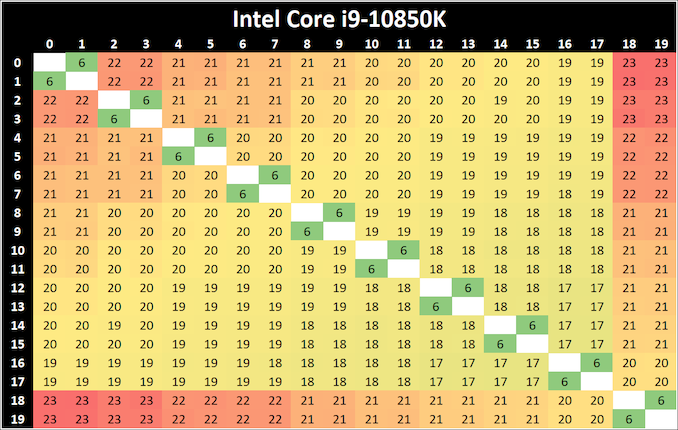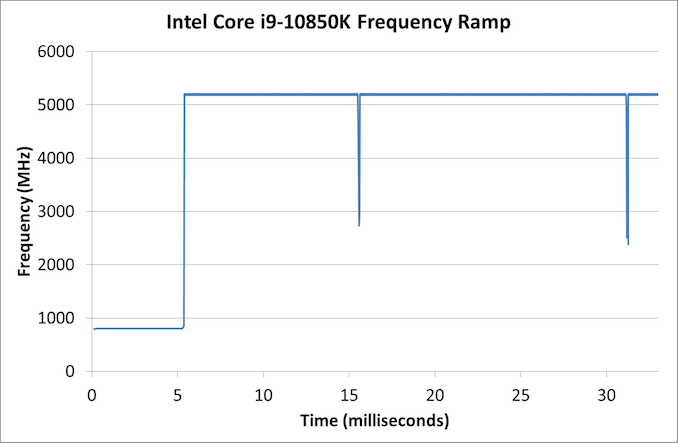Intel Core i9-10850K Review: The Real Intel Flagship
by Dr. Ian Cutress on January 4, 2021 9:00 AM EST- Posted in
- CPUs
- Intel
- Core
- Z490
- 10th Gen Core
- Comet Lake
- LGA1200
- i9-10850K
CPU Tests: Microbenchmarks
Core-to-Core Latency
As the core count of modern CPUs is growing, we are reaching a time when the time to access each core from a different core is no longer a constant. Even before the advent of heterogeneous SoC designs, processors built on large rings or meshes can have different latencies to access the nearest core compared to the furthest core. This rings true especially in multi-socket server environments.
But modern CPUs, even desktop and consumer CPUs, can have variable access latency to get to another core. For example, in the first generation Threadripper CPUs, we had four chips on the package, each with 8 threads, and each with a different core-to-core latency depending on if it was on-die or off-die. This gets more complex with products like Lakefield, which has two different communication buses depending on which core is talking to which.
If you are a regular reader of AnandTech’s CPU reviews, you will recognize our Core-to-Core latency test. It’s a great way to show exactly how groups of cores are laid out on the silicon. This is a custom in-house test built by Andrei, and we know there are competing tests out there, but we feel ours is the most accurate to how quick an access between two cores can happen.
When we first reviewed the 10-core Comet Lake processors, we noticed that a core (or two) seemed to take slightly longer to ping/pong than the others. We see the same pattern here again with the final core.
Frequency Ramping
Both AMD and Intel over the past few years have introduced features to their processors that speed up the time from when a CPU moves from idle into a high powered state. The effect of this means that users can get peak performance quicker, but the biggest knock-on effect for this is with battery life in mobile devices, especially if a system can turbo up quick and turbo down quick, ensuring that it stays in the lowest and most efficient power state for as long as possible.
Intel’s technology is called SpeedShift, although SpeedShift was not enabled until Skylake.
One of the issues though with this technology is that sometimes the adjustments in frequency can be so fast, software cannot detect them. If the frequency is changing on the order of microseconds, but your software is only probing frequency in milliseconds (or seconds), then quick changes will be missed. Not only that, as an observer probing the frequency, you could be affecting the actual turbo performance. When the CPU is changing frequency, it essentially has to pause all compute while it aligns the frequency rate of the whole core.
We wrote an extensive review analysis piece on this, called ‘Reaching for Turbo: Aligning Perception with AMD’s Frequency Metrics’, due to an issue where users were not observing the peak turbo speeds for AMD’s processors.
We got around the issue by making the frequency probing the workload causing the turbo. The software is able to detect frequency adjustments on a microsecond scale, so we can see how well a system can get to those boost frequencies. Our Frequency Ramp tool has already been in use in a number of reviews.
The Core i9-10850K ramps up extremely quickly from idle to peak turbo, in the region of about 5 milliseconds. This is faster than the 16 ms we typically observe.












126 Comments
View All Comments
YB1064 - Monday, January 4, 2021 - link
Thermals look horrendous! 102 C even when throttled is bad. Even with water, I don't think you will see much improvement. Better have a chiller on hand!GeoffreyA - Monday, January 4, 2021 - link
The sun should buy a few million of these fellows. Will help a lot with temperature when sunspots get too cool.at_clucks - Monday, January 4, 2021 - link
Nooo, as the article puts it, it's "not as bad as it sounds". People just needlessly freak out when they processor FREAKING BOILS WATER on "an open test bed with a chunky copper cooler" and needing 270W at full load. But in reality it's just "more about thermal gradients inside the processor and how easily the thermals can move" so it's all good. I can feel the temps dropping just by reading these comforting words.I guess the only thing that can make a current gen Intel CPU look good is another current gen Intel CPU. Here's hoping that they get their act together for the next gen(s) or we'll keep having to read reviews where Intel competes against Intel as the only way to get some praise.
at_clucks - Monday, January 4, 2021 - link
Read the comment above as if there was an edit button to fix all the grammatical... inconsistencies.1_rick - Monday, January 4, 2021 - link
It's no worse than the article itself.Smell This - Monday, January 4, 2021 - link
as the article puts it, it's "not as bad as it sounds"_______________________________________
Sadly, the presentation makes it much worst. Bad enough smoked with the Ryzen 5900x ... there is little to no downward price pressure on an 18-month old AMD 3900x at $499.
Even worst --- 18 months ago the HEDT Intel 12/24 i9-79xxX was $1,190 and was slobber-knocked by the 3900x . . .
GeoffreyA - Wednesday, January 6, 2021 - link
"Here's hoping that they get their act together"Rocket Lake should cover the ground performance-wise, but it's going to be disastrous when it comes to power and heat. Would be nice to see Sunny Cove running on 7 or 5 nm, but I suspect even there, Zen 3 would use less power, owing to its more economical design.
powerarmour - Monday, January 4, 2021 - link
It's a genuinely horrible CPU compared to the competition, Intel have regressed so much on performance-per-watt that even Apple are stealing their lunch now.shelbystripes - Monday, January 4, 2021 - link
It’s embarrassing (for Intel) how easily Apple justified the Intel-to-ARM switch with the M1. Stagnation is a bitch.Operandi - Monday, January 4, 2021 - link
Part stagnation part major technological fumbles. Intel definitely played it safe on the architectural level but you could argue that was the right call given the state of the market. What is really killing them is the dropped ball on the fabrication front.Regardless though Apple's move to their own designs was going to happen even if Intel was stumbling all over the place, that move has been planned for over a decade.